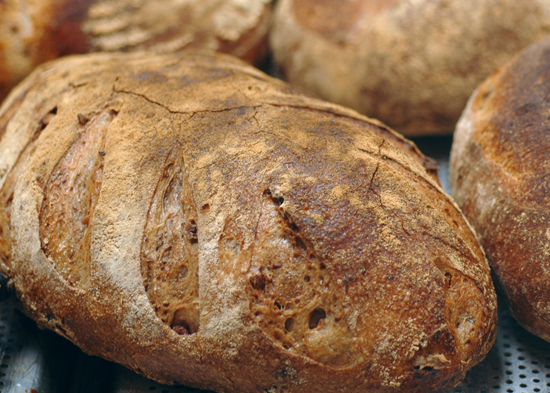ICE offers one of the country’s largest recreational cooking programs. With over 1,500 cooking classes and over 26,000 students each year, there is something for every cook looking to learn new techniques in the kitchen. Last month, food writer Jamie Feldmar, whose work is regularly seen on Serious Eats and in the Edible magazine series, tackled her fear of baking in Artisan Breads At Home with Daniel Rosati.

Like many people, I am afraid to bake. I can cook — not perfectly, but well enough to feed myself, and with enough confidence to occasionally feed other people. Baking, though, has never been my forte — the measuring, the careful mixing, and the endless waiting for the finished product — it’s just not for me.
Bread, in particular, has always been daunting. I don’t understand yeast in the slightest, and I can’t knead to save my life. So when I was looking for a class at ICE, bread baking was not my first instinct. But as I flipped through the enormous catalog, circling savory cooking classes that sounded interesting, a nagging voice in the back of my head told me that maybe this was the time to take on a challenge. Maybe it was time to tackle bread. So I signed up, with great trepidation, for Artisan Breads At Home, taught by Daniel Rosati.
I started to relax a little once I got into the kitchen. Rosati had ingredients for each of the five pieces of bread we’d be making measured and neatly arranged ahead of time, and we spent the first half hour simply talking as a group. He explained the different kinds of yeast, their characteristics and how to use them; ditto for flours and ovens. He explained some of the tips and tricks professional bakers have at their disposal, and how to recreate them at home. For example, that steam-creating proof box in commercial bakeries? Make one of those by placing your dough in a bowl inside a tub of warm water and covering it with a towel.
Once we had the terminology down, it was time to actually bake. Well, sort of. All of the breads — the herb-laced Provencal ring, the cranberry pecan rolls, the Turkish pide flatbread, the Apulian Altamura bread and the French three-grain Saracen — needed time to rise, so what I should say is that it was time to mix our brewer’s yeast into our dry ingredients and let them sit in our jerry-rigged proof box for a while. I was shocked at how easy it was to simply mix everything together in a standing Kitchenaid mixer.
I had visions of slaving over a giant ball of unruly ingredients and mixing everything by hand. “It’s 2012 — time to get a mixer,” laughed Rosati. While we waited for the dough to rise, we mixed our tapenade for the Provencal bread and our toasted hazelnut and spice mix (dukkah) for the flatbread. Oh, and we drank wine. Then it was time to knead, which Rosati handled, for the most part, showing us his well-practiced quarter-turn and fold technique. This was the only labor-intensive part of the class, and to call it “intensive” is really an overstatement — all the pieces of bread just needed some quick handling. Rosati then helped us shape and score each of the pieces of bread into their appropriate figures — rings, loaves, boules, rolls, oblong ovals, etc. This part is a little nerve-wracking. You really only get one chance to properly score the dough, and it’s a quick, deft motion that takes practice.
After those finishing touches, the pieces of bread go in the oven, and although Rosati made the caveat that “in a perfect world, we’d allow each of these pieces of bread to come out, cool completely [to let their crusts harden perfectly], then reheat them before serving,” of course that didn’t happen. We dug into the pieces of bread, fresh and hot out of the oven. I, of course, thought they tasted fantastic just the way they were. For me, learning what yeast actually is and getting my hands dirty really helped demystify the whole bread baking process. The ease in mixing and kneading helped lessen some of my big technical concerns. I definitely think I can recreate one or two of the artisanal breads in my home kitchen — imperfect crust and all.



